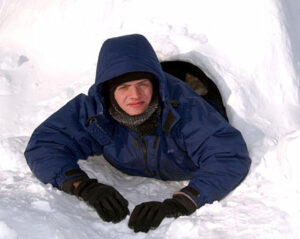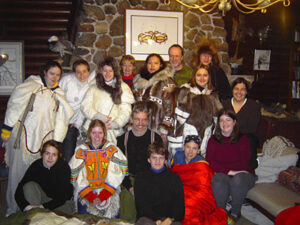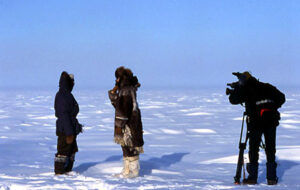This article was originally published in March 3, 2004 on the website sportshooter.com
Four women and a photographer in an Igloo

Six weeks ago I with camera in hand, sleeping bag draped over my shoulder and a caribou skin under one arm slept in a igloo with four other hearty Canadians after a night of feasting on wild beaver and listening to Inuit tales.
The journey that brought me to my snowy home began when I met instructors Rick Riewe and Jill Oakes while covering last year’s course. I was invited to sleep in the igloo, but deadlines etc forced to leave.
Heading out along the rural access road to the station I realized we were in for quite a night when blowing snow created drifts of 1 to 2 feet deep. I met with a Global TV crew who said the road was impassable and we sat and waited for the staff to plow the road.
Temperatures for the day were in the -20 C with wind-chill of -35 C (-31 F). A large dump of snow left well over 30 cm (one foot) on the ground and with the help of snow fences (like those seen at World Cup Skiing Events) there was more than enough snow.
Carley Basler, Karin Johansson, Corinna Gascho and Paula Hughson were just names of strangers, but now they were fellow igloo builders and my bunkmates for the night. I was using F90X (N90s) for couple hours before it needed to be warmed up a bit, so I shoved the batteries down my pants and got to work on building my future home.

We had to dig down a couple of feet to find so hard pack snow, the perfect density need for cutting the building blocks.
The blocks can be 2.5 feet across and weight up to 20 pounds. Just carrying the blocks 10-20 feet provided a massive undertaking, making you sweat through the day.
As we were putting our final blocks in place, I was assigned the task of filling all the holes; small little holes can ruin a good nights sleep, so the igloo should be seamless.
After a day of building we sat down to a dinner of wild beaver, Riewe and Oakes had picked up from taxidermist days before.
The kitchen was a very hot and humid place, and the gear suffered, even with a bag I couldn’t warm it up. Sportsshooter.com member and NPS guru Ronal Taniwaki suggested that it would have taken over 2 hours to warm the camera to the conditions of the kitchen.
Later that night we carried out our caribou skins across the snow covered lake as the northern lights danced across the skies. The five of us slowly climbed in. When you get into an igloo you have to gingerly get into your bag without touching any of the walls or ceiling which proved quite difficult for someone who is 6 feet tall.
We sealed up the door and prepared for the night. Sadly I couldn’t take any photos yet due to the camera being fogged from the long wait to get in from the cold. The moisture was the foe of the camera but the friend to us. It was the moisture, which kept us warm, the combined heat of five people makes it amazingly comfortable.
Taniwaki had suggested trying to keep your body heat away from the camera or warming it up in your sleeping bag before using.
As the night passed the overnight low was a -37 C (-34 F) outside and once you crack open the door of an igloo you’ll never get that heat back. This proved quite important, as you had to learn how to go pee inside.
Professor Riewe told us stories about how the top hunter always gets the centre, the warmest spot, and being a white man Riewe found himself on the edge of the igloo quite often and when he needed to go pea to go against the wall.
For myself it wasn’t that easy, any rules of etiquette are through out the window, if we had one. I am in an igloo with four women I didn’t even know six hours ago, I have my pants around my ankles hugging a wall hopping that I am not hitting anything.
It wasn’t much easier for the women who had to pull back the caribou skins and put their bum to the cold wall and squat.
You mind is very active the first time your in an igloo, it is a different environment and at times I felt getting colder and colder, during those times, I got a little closer to companions and though I was warm. I then felt my body getting warmer and warmer, it isn’t something I can explain, other then I was warm and fell asleep.
During my slumber, I had some unusual dreams, as most people do their first time, I still wonder why I was having thanksgiving dinner with Trent Nelson and family, don’t ask, I wouldn’t be able to tell you.
Other then one’s internal clock it is hard to know when morning comes. The blocks are so thick and the seal so tight barely any light leaked through.

I picked up the camera ready to make a group shot us surviving the night and just to touch of my warm body to camera was enough to fog it. Sadly there was little room in my sleeping bag for it or I would have brought it in but keeping warm throughout the night was beyond photography at this point.
We broke the seal on a clear calm Sunday morning at -20 C and left for coffee and a hot breakfast in the kitchen.
Driving home with the new experience, I found a difference in covering an event and being part of one. I just recently got back my slides and they were different then the ones I had shot in the previous year, I don’t believe they were as good.
Sports Shooter’s Bert Hanashiro and others have talked about assignments that have changed their life, getting to close to the subject at hand, and not being totally objective, but for this instances, I decided to take a step back and be part of the experience.
It was a great one to have and I believe helps you focus when you have a job at hand.
The University of Manitoba has been running the program for 30 years at the Delta Marsh Field Station over two weekends in the month of January.
This article was originally published in March 3, 2004 on the website sportshooter.com